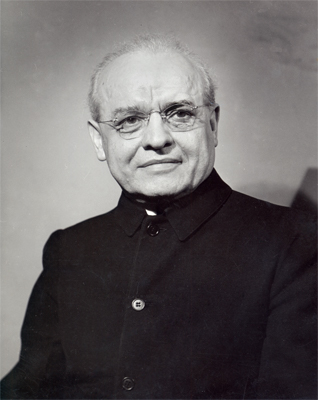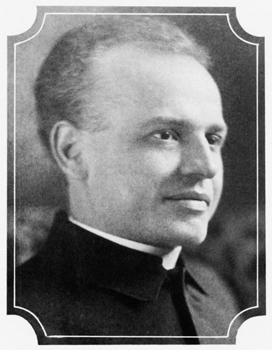St. Louis Cultural History Project—Fall 2019
The Crown Prince of Caroline Avenue:
Alphonse Schwitalla, S.J.(1882-1965)
and the Saint Louis University Medical Center
by John Waide, M.A.

Throughout the history of Saint Louis University, there have been numerous individuals who tended to evoke intense feelings, both positive and negative, from those who knew or worked with the person. Although I never had the pleasure of meeting Father Alphonse Schwitalla, I have had the opportunity of speaking with many people here at the University, and in St. Louis, who knew him quite well. From what these people have told me, I believe it is fair to say that Father Schwitalla was one of those individuals here at SLU who did evoke strong feelings! The first part of the title of this presentation, The Crown Prince of Caroline Avenue,
is a sarcastic appellation used by many to describe what they perceived as Father Schwitalla’s rather imperious
attitude towards the University’s medical center and hospital. Regardless of one’s personal feelings towards Schwitalla, virtually everyone agrees that he was an incredibly active and accomplished man, and Saint Louis University, as well as many others both here in St. Louis and across the United States, owe him a great deal.
Alphonse Mary Schwitalla was born in Beuthen, Upper Silesia, Germany on November 27, 1882. Although Upper Silesia was a part of Germany at the time, Schwitalla’s nationality was probably Polish. He was one of six children born to Peter Schwitalla, a tailor, and his wife Pauline. He moved to St. Louis with his parents when he was only three years old. Alphonse had two brothers, Alexis and Alfred, and three sisters, who all became members of the School Sisters of Notre Dame. Their religious names were Sister Mary Loyola, Sister Mary Gonzaga, and Sister Mary Alphonsella. As a child attending school in St. Louis he was remembered by his contemporaries as having been different
as he was always reading books while his young contemporaries were playing sports or engaged in other outdoor activities. He attended the Academy (the high school) here at Saint Louis University from 1895 to 1899. In July, 1900, Alphonse entered the Missouri Province of the Society of Jesus at St. Stanislaus in Florissant, a few months before his 18th birthday. He received his A.B. degree from Saint Louis University in 1907 and his A.M. degree from SLU in 1908. He was ordained a Catholic priest in 1915.
Between 1908 and 1918, Schwitalla taught chemistry and biology at three different Jesuit colleges, St. Xavier’s in Cincinnati, Saint Louis University, and Rockhurst in Kansas City. In 1918, the Jesuits sent him to Johns Hopkins University in Baltimore for graduate school. Father Schwitalla received his Ph.D. in Zoology from Johns Hopkins in 1921. Schwitalla, like his contemporary Father Macelwane, was among a group of young Jesuits at the time who were being sent to the finest secular
q> universities in the country for their graduate training. (Father Macelwane received his Ph.D. in Physics from the University of California—Berkeley in 1923.) Schwitalla was the first Jesuit to study in the Biology Department at Johns Hopkins, and Johns Hopkins would later call Father Schwitalla one of its most distinguished
alumni and "one of the five leading medical instructors" in the United States.
Father Schwitalla returned to Saint Louis University as an associate professor of biology, and he soon found himself director of the department and then regent of the School of Medicine in 1924. He was appointed dean of the School of Medicine in 1927, a position he held until his retirement for health reasons in 1948. He was named Professor Emeritus in the Department of Biology and Dean Emeritus of the Medical School after he retired.
Besides these positions, Father Schwitalla also held the following posts here at SLU: Regent, School of Dentistry, 1924-44; Acting Dean of the Graduate School, 1926-29; and Dean of the School of Nursing, 1929-44. He also served as president of the Catholic Hospital Association of the United States and Canada from 1928 to 1947, when he was named President Emeritus of the CHA.

Early on in his career here at SLU Father Schwitalla established the St. Mary's Group of Hospitals in 1924. This hospital group consisted of St. Mary's Infirmary, St. Mary's Hospital, and Mount St. Rose Sanatorium. Together, these hospitals were conducted as the University Hospital. Their medical and educational activities were under the control of the University, while most of the staffing was overseen by the Sisters of St. Mary. In 1933 the newly completed Firmin Desloge Hospital supplanted St. Mary's Infirmary as the chief teaching center of the University's Medical School. I would like to read the following from a document entitled The Interpretative Statement of the Firmin Desloge Hospital
written in 1948. Remember that Father Schwitalla was right in the middle of all of the action being described in this report:
The present Hospital [Firmin Desloge] was opened for operation on January 16, 1933. In regard to its purpose and general organization, it is the successor of the old St. Mary's Infirmary at Fifteenth and Papin Streets, which, prior to the development of the Firmin Desloge Hospital, served the same purposes for the Sisters of St. Mary and St. Louis University as does the present Firmin Desloge Hospital. At the time when the Firmin Desloge Hospital was opened, a new purpose was found for St. Mary's Infirmary, when it was dedicated to the use of colored patients in charge of a colored staff but under the conduct of a white Sisterhood. . . .
His key collaborator in much of this work was Mother Concordia Puppendahl of the Sisters of St. Mary’s. Like Father Schwitalla, Mother Concordia was a larger than life figure in the history of medicine and hospitals here in St. Louis, but hers is a story for another day!
In 1926 Schwitalla organized the Corporate Colleges of Saint Louis University, a union of nine area Catholic women’s colleges with the University that allowed these smaller women’s schools to increase their academic level and standing. That same year he also set up the Department of Medical Social Service. He oversaw the reconstruction of the School of Medicine in 1927 and the creation of the School of Nursing in 1928. In 1948 he put through the expansion of the Medical School building, which after his resignation as dean later that year was named Schwitalla Hall in his honor.
Father Schwitalla held numerous appointments in the American Medical Association. He coauthored the famous minority report to the study on the costs of medical care undertaken by the organization between 1928 and 1933, defending the traditional doctor-patient relationship against what he viewed as the dangerous encroachment of government regulation. He also helped to evaluate the nation's medical schools in the report Medical Education in the United States,
researched by the Association between 1934 and 1939.
During his many years of work with the North Central Association of Colleges and Secondary Schools Schwitalla inspected approximately 50 colleges and fostered the recognition by the group of the services contributed to higher education by those members of religious orders involved in teaching and administration. From 1936 to 1937 he was president of the North Central Association.
Internationally renowned as a hospital and medical authority, Schwitalla was much in demand as a conference speaker and wrote over 100 papers on biology, medical ethics, medical and nursing education, social hygiene, hospital administration, and the position of the physician in society. From 1928 to 1947 he edited Hospital Progress, the journal of the Catholic Hospital Association.
Without the benefit of a medical degree, Schwitalla rose to prominence as one of the most widely known medical educators in the country. In 1922 he was invited by Clarence Darrow, counsel for the defense in the infamous “Scopes Monkey Trial” in Tennessee, to serve as an expert witness on evolution. Although it was not necessary for him to appear at the trial after-all, Father Schwitalla was prepared to testify in support of the high school teacher who taught his students the theory of evolution. In 1948, Father Schwitalla became the first non-physician to receive the certificate and gold medal of the American Medical Association for outstanding effort for the public welfare on a national level.
Later in life Schwitalla suffered a great deal from ill health. In October 1941 he underwent an operation to relieve pressure on his spinal cord which was causing him some discomfort, and barely six months later, in April 1942, he was seriously injured in an automobile accident while on his way to Columbia, Missouri, to deliver a speech. Few people realize that Father Schwitalla was hoping to serve as a chaplain for the 70th General Hospital, an overseas hospital unit for World War II being organized by the University, but because of his back problems and the accident, he could not go. Instead, Father Harry Crimmins, President of Saint Louis University, resigned his position as University President to serve as chaplain. In October 1948 Father Schwitalla suffered a severe stroke that left him practically bedridden for the next six years. He died at the age of 82 on May 25, 1965, at St. Mary's Hospital.